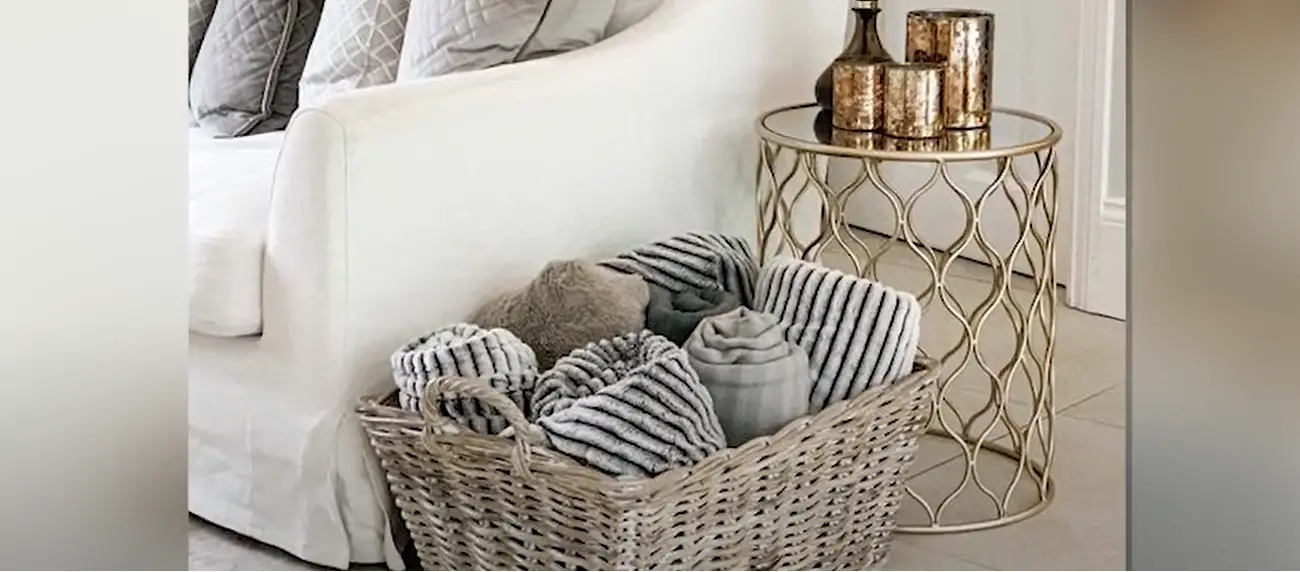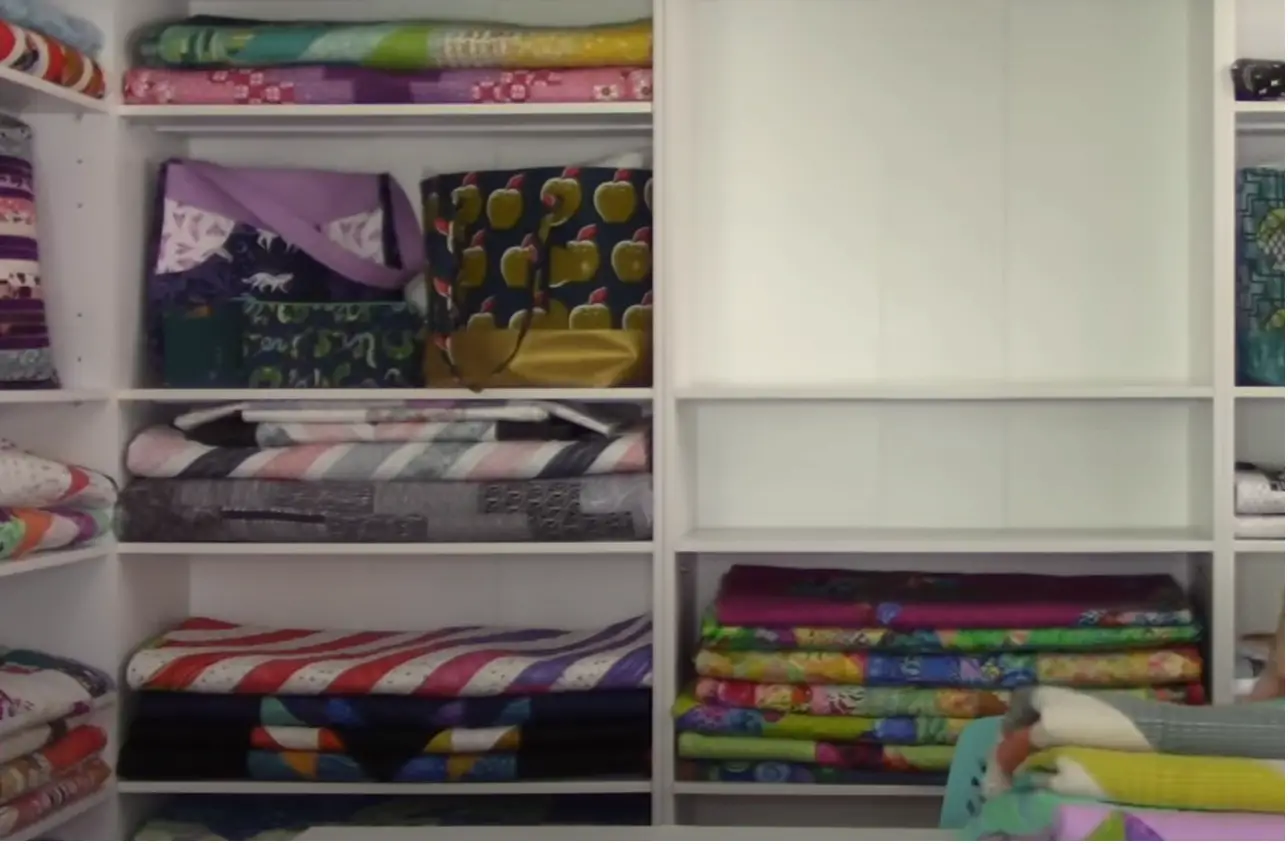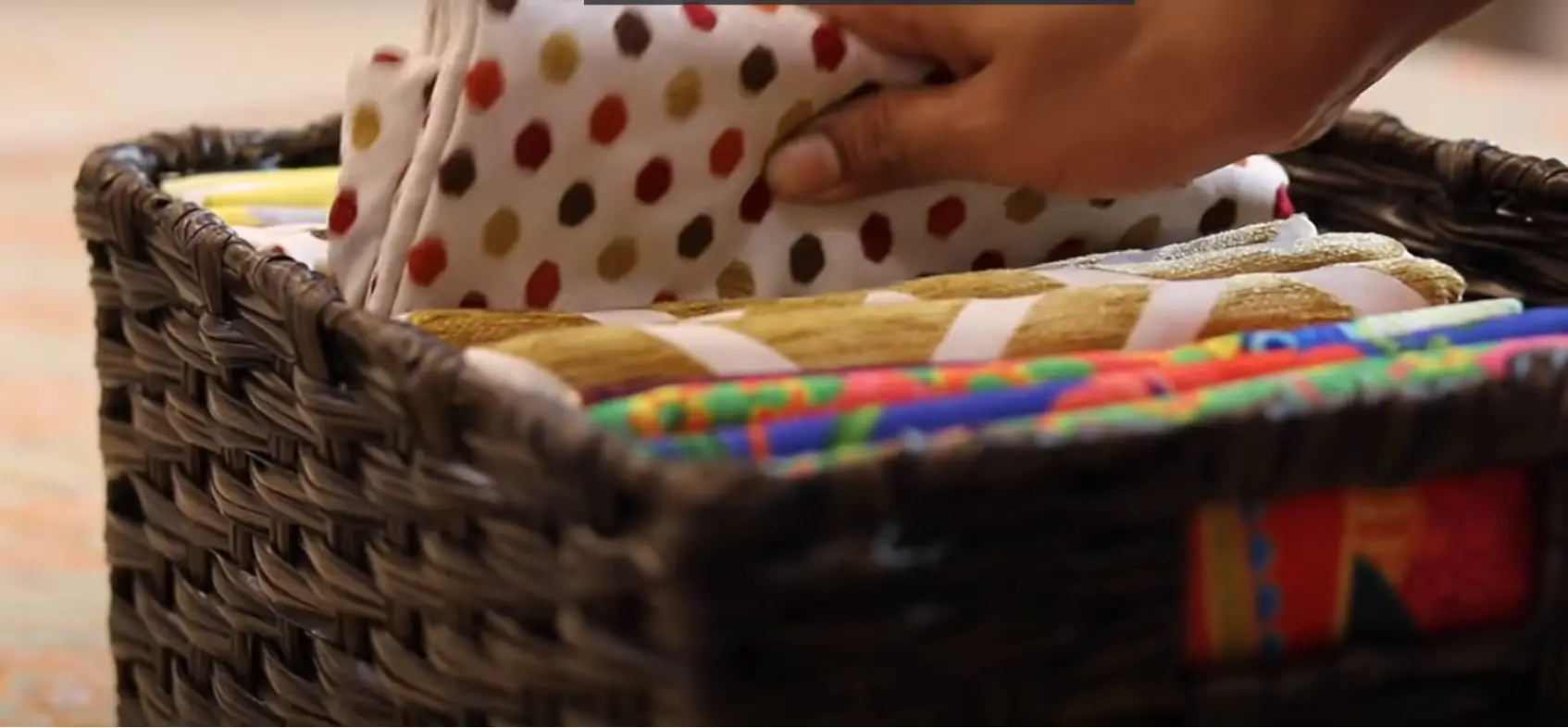Living rooms come in all shapes and sizes. Some people choose to have a large open space where they can entertain guests, while others prefer a more cozy and intimate setting. No matter what your living room style is, one thing remains the same: there needs to be a place to store blankets! In this guide, we will provide useful tips on how to store blankets in a living room so that you can stay organized and keep your space looking neat and tidy.
Benefits of Having a Designated Storage for Blankets

You might wonder why you should go through the trouble of creating a designated storage space for blankets. After all, you can just keep them in a pile on your couch or stuffed in the back of your closet. But here are actually a few reasons why it’s important to have a specific place to store blankets.
It helps to keep them clean
One benefit of having a designated storage area for blankets is that it can help to keep them clean. When blankets are stored in a place where they are not frequently used, they are less likely to become stained or dusty. Additionally, if you have pets or small children, they might not be as careful with your blankets as you are and end up spilling food or tracking dirt onto them.
Another reason is that it will protect your blankets from getting damaged. If they’re just thrown into a closet, they could easily lose their shape or get caught on something and rip. But if they’re stored in a bin or on a shelf, they’ll be much less likely to become damaged.
It keeps everything organized
Another benefit of having a designated storage area for blankets is that it helps to keep everything organized. If you have a lot of blankets, they can quickly become a tangled mess. It also can help to make the living room appear more organized and tidy. This is especially important if the living room is small or if it is shared with other rooms such as a dining room or home office. By storing blankets in a specific area, it will be easier to keep the living room looking neat and stylish.
Additionally, if you store your blankets in an open space like on a shelf, it can also serve as decoration. You can fold them neatly and stack them in an aesthetically pleasing way that will add to the overall look of your room.
It makes them easily accessible
Organizing your blankets in a designated storage area can also make them more easily accessible. If you store them in a bin or on a shelf, you can stack them neatly and know exactly where everything is. This is especially helpful if you need to grab a blanket in a hurry – you won’t have to search through a pile of them to find the one you want. [1]
How to Store Blankets in Your Living Room

Now that we’ve gone over some of the benefits of having a designated storage area for blankets, let’s talk about how to actually store them. Here are a few tips to help you get started.
Get yourself a storage bench
One great way to store blankets in your living room is to get yourself a storage bench. A storage bench is a piece of furniture that has a seat and usually some sort of storage underneath. This is a great option because it allows you to keep the blankets out of the way but still easily accessible. Additionally, it can double as extra seating when you have guests over. You can also add a few decorative items, such as throw pillows or vases, to make the display more visually appealing.
Just make sure to choose a storage bench that is the right size for your needs and that will fit well in your living room. You also want to make sure that it has enough ventilation so that the blankets don’t get musty. [1], [2]
Use a basket
Baskets and bins are by far the most casual option for storing blankets. They are a great option if you have a lot of blankets or if you want to keep them organized. Baskets are especially helpful if you want to be able to grab a blanket quickly as you can just throw them in the basket and know exactly where they are.
Bins are usually larger than baskets so you can fit more blankets in them. Additionally, bins often come with lids which can help to keep the blankets clean and dust-free.
There are several types of baskets and bins that you can choose from. Each type serves well as a storage unit for your blankets, but has its own set of pros and cons.
Wire baskets
Wire baskets are a great option for storing blankets because they are durable and have a lot of ventilation. Additionally, wire baskets often come with handles which makes them easy to carry. However, some people might not find wired baskets aesthetically pleasing to be displayed in their living room. [1], [2]
Woven baskets
Woven baskets are a type of basket that is made by knotting or interlacing strips of material. Woven baskets are often made out of materials like wicker, rattan, or straw. Woven baskets are a great option for storing blankets because they are durable and stylish.
Woven baskets are also known to be flexible which can be helpful if you need to store oddly shaped items.
The downside of knotted baskets is that they can be more expensive than other types of baskets. Additionally, the knots can come undone over time which can cause the basket to fall apart.
Wooden baskets

Wooden baskets are another great option for storing blankets. They are much more stylish than wired baskets and are also extremely durable. Wooden baskets also can easily add a more traditional and warm feel to your living room.
The downside of wooden baskets is that they can be more expensive than other types of baskets. Additionally, if the basket is not made from high-quality wood, it can warp or crack over time. And you need to watch away for moisture because it can cause the wood to rot. [4], [5], [6]
Hide them in a storage ottoman
Another option for storing blankets in your living room is to hide them in a storage ottoman. A storage ottoman is a piece of furniture that has a lid and usually some sort of storage inside. It is a great way to keep blankets close at hand while also keeping them out of sight. Most storage ottomans have hinged lids that open up to reveal plenty of space inside for storing folded blankets. And, when closed, they can double as extra seating in the same way as a storage bench.
Just make sure to choose a storage ottoman that is the right size for your needs and that will fit well in your living room. You also want to make sure that it has enough ventilation so that the blankets don’t get musty. [1], [2]
Use storage tables
One of the most popular ways to store blankets is to use storage tables. These are typically small, low-profile pieces of furniture with shelves that are perfect for storing folded blankets. Storage tables come in a variety of styles and can be made from different materials, so you should have no trouble finding one that fits your needs and matches your décor.
Another advantage of using storage tables is that they can double as a place to display other decor items like plants, vases, and photos, or even have a cup of coffee. [1], [2]
Hang them on a ladder
One way to store blankets in your living room is to hang them on a blanket ladder. A blanket ladder is a great way to store multiple blankets while still keeping them within easy reach. This is a great option if you have a lot of wall space and want to make a statement. You can arrange the blankets in any pattern or design that you want. You could even paint the ladder to match your décor if you want it to blend in more. It’s a very stylish way to store blankets and can serve as decoration in your living room.
To hang blankets on a ladder, simply drape them over the rungs of the ladder. You can hang them all in the same direction or alternate between hanging them vertically and horizontally.
Another benefit of this method is that it keeps the blankets off the floor where they could get dirty or be stepped on. And, if you have pets, they might be less likely to lay on the blankets if they’re hung up out of reach.
If you don’t have a blanket ladder, you could also use a regular ladder or even a towel rack. Just make sure that whatever you use is sturdy enough to support the weight of the blankets. You could also use S-hooks to hang the blankets from the rungs of the ladder for a more secure hold. [1], [2]
Get a separate shelf for blankets

You can find some really great shelving options at your local home improvement store or online. Just make sure to measure the dimensions of your living room before you buy anything so you know what will fit.
Another option is to repurpose an old dresser into a blanket storage unit. This is a great way to add some extra storage to your living room without taking up too much space. Plus, it gives you the opportunity to get creative and add your own personal touch to the piece. [2]
Hang them on a clothing rack
If you have a clothing rack in your living room, you can use it to store blankets. Simply fold each blanket neatly so that it hangs evenly on the rack. This is a great option if you want to be able to see all of your blankets at once and easy access to them.
Another advantage of this method is that it keeps the blankets from getting wrinkled or damaged. If you don’t have a lot of floor space in your living room, hanging blankets on a clothing rack is also a good way to save space.
Just make sure that the rack is sturdy enough to hold the weight of the blankets. And if you’re hanging heavier blankets, like quilts, you may want to invest in some S-hooks or similar hardware to help distribute the weight evenly. [1], [2]
General Tips on How to Store Blankets Properly

So now that we’ve gone over some specific ways to store blankets in a living room, let’s talk about some general tips. These tips will help you keep your blankets clean and in good condition so that they last longer.
Clean your blankets before storing them away
One of the most important things you can do to prolong the life of your blankets is to clean them regularly. This will remove any dirt or debris that could cause damage or premature wear and tear. Washing also helps to restore the natural loft of the fibers, which can make them feel softer and more comfortable.
When washing blankets, it’s important to use the right type of detergent. Avoid using harsh chemicals or bleach as these can damage the fabric. Instead, opt for a mild detergent designed for delicate fabrics. For example, when cleaning wool blankets, it’s important to use a special wool-safe detergent. You can find these at most stores that sell laundry supplies. Some wool blankets are also dry-clean only, so be sure to check the care label before washing.
After washing, it’s important to dry your blankets properly. The best way to do this is to air-dry them. If you must use a dryer, set it to the lowest heat setting and remove the blankets as soon as they’re done drying. Never put wet or damp blankets in a dryer as this can damage the fabric.
It’s also a good idea to store your clean blankets in a cool, dry place. Avoid storing them in direct sunlight or near any type of heat source as this can cause fading or damage.
Avoid storing them in humid places
Another important tip is to avoid storing blankets in humid places. This includes places like the attic or basement, which can be susceptible to moisture. Make sure your living room and storage solution are climate-controlled to keep your blankets in good condition.
If you must store blankets in these areas, be sure to put them in a storage container with a lid to keep them from getting damp.
Allow them to breathe
Another important tip is to allow your blankets to breathe. This means that you should not store them in airtight containers or plastic bags. Doing so can cause musty odors and encourage the growth of mold and mildew.
When storing blankets long-term, it’s important to inspect them periodically for signs of damage or pests. If you notice any damage, be sure to have the blanket cleaned and repaired as soon as possible. This will help prevent further damage and extend the life of the blanket. You may also want to invest into mothballs or another type of pest control to keep moths and other insects from damaging your blankets. [3]

Comparison of Methods for Storing Blankets in a Living Room
This table compares different methods for storing blankets in a living room. It provides a comparison of various indicators to help you choose the most suitable storage method for your blankets. The measurements are presented in the imperial system.
The table includes five key indicators: Space Required, Ease of Access, Protection from Dust, Aesthetics, and Cost. Each indicator is rated on a scale of 1 to 5, with 1 being the lowest and 5 being the highest. A higher rating indicates better performance for that particular indicator.
| Storage Method | Space Required | Ease of Access | Protection from Dust | Aesthetics | Cost |
|---|---|---|---|---|---|
| Folded in a Basket | 2 | 4 | 3 | 4 | 2 |
| Under Bed Storage | 5 | 3 | 5 | 3 | 3 |
| Wall-Mounted Hooks | 1 | 5 | 2 | 5 | 4 |
| Storage Ottoman | 3 | 4 | 4 | 4 | 5 |
| Blanket Ladder | 4 | 3 | 5 | 3 | 3 |
Please note that the table is for illustrative purposes and the ratings assigned to each indicator are subjective. The ratings may vary depending on personal preferences and the specific characteristics of the living room.
FAQ
How do you store blankets in less space?
If you have a lot of blankets, it can be tough to find a place to store them all. But usually, you should have no problems by installing some shelves or getting some storage baskets. You may also get a storage bench as it will come in handy. Clothing racks are also an excellent way to save space since you can store several blankets on them.
What is the best way to store blankets and sheets?
The best way to store blankets and sheets is by using a storage ottoman or chest. This will keep them out of the way and prevent them from getting dusty. You can also use a vacuum sealed bag to compress the items and save space.
Another option is to fold the blankets and sheets and place them on shelves. This is a good idea if you have limited space, as it will allow you to make better use of the vertical space in your room. Be sure to label the shelves so that you know where each item is stored.
Is it OK to store blankets in plastic bags?
Storing your blankets in plastic bags is perfectly fine, as long as the bags are breathable. You don’t want your blankets to get musty, so make sure to choose a bag that will allow air to circulate. You can find these types of bags at most home goods stores.
Another option is to invest in some storage bins specifically designed for storing blankets. These often have lids that seal shut, keeping out dust and pests. And, they come in a variety of sizes so you can find one that fits your needs.
How should I store blankets in a living room?
Storing blankets in a living room can be done in a few different ways, depending on the available space and your preferences. Here are a few options:
- Blanket basket: Use a decorative basket or a woven storage container to neatly stack your blankets. This allows easy access and adds a cozy touch to the living room decor.
- Blanket ladder: A blanket ladder is a stylish and practical solution. Lean it against a wall and drape your blankets over the rungs. It adds visual interest and keeps the blankets easily reachable.
- Blanket storage ottoman: If you have an ottoman with a storage compartment, it can serve as a dual-purpose piece. Fold and place the blankets inside the ottoman for a hidden storage solution.
- Blanket storage chest: A blanket chest or trunk is a classic option for storing blankets. Place it at the foot of the bed or in a corner of the living room and stack your blankets neatly inside.
Choose the storage option that suits your living room’s style and space constraints.
Are there any tips for folding blankets before storing them?
Proper folding can help you maximize space and keep your blankets in good condition. Here are some tips for folding blankets:
- Smooth out wrinkles: Before folding, make sure your blankets are smooth and free of wrinkles. This will help prevent creases and maintain their quality.
- Choose a suitable size: Fold the blanket to a size that fits your chosen storage solution. Avoid excessive folding, as it can lead to unnecessary wear and tear.
- Fold neatly: Start by folding the blanket in half lengthwise, then fold it in half again. For larger blankets, you may need to fold them into thirds or quarters. Aim for even, straight folds.
- Stack or roll: Depending on your storage method, you can stack folded blankets or roll them up. Rolling can help save space and prevent deep creases.
- Use acid-free tissue paper: If you want to provide extra protection, place acid-free tissue paper between folded blankets to prevent color transfer or friction damage.
Remember to handle your blankets with care to preserve their quality and prolong their lifespan.
How can I prevent musty odors when storing blankets in a living room?
Moisture and lack of airflow can lead to musty odors in stored blankets. To prevent this, consider the following tips:
- Clean and dry: Before storing blankets, ensure they are clean and completely dry. Any residual moisture can promote mold or mildew growth.
- Avoid plastic bags: While it may be tempting to store blankets in plastic bags for protection, this can trap moisture and cause odors. Opt for breathable storage solutions instead.
- Use natural materials: If possible, choose storage containers made of natural materials like cotton or canvas. These materials allow airflow and help prevent trapped moisture.
- Include moisture absorbers: Place moisture-absorbing products like silica gel packets or moisture-absorbing crystals near the stored blankets. These help to reduce excess moisture in the surrounding environment.
- Regularly air out: Periodically take out the blankets and give them some fresh air to prevent musty smells from developing. Hang them outdoors or in a well-ventilated area for a few hours.
By following these tips, you can keep your stored blankets smelling fresh and free from musty odors.
Should I use any protection for blankets when storing them in a living room?
Protecting your blankets during storage can help preserve their quality. Here are a few options:
- Cotton or muslin covers: Consider using cotton or muslin covers to protect your blankets from dust, dirt, and potential pests. These covers allow airflow and prevent moisture buildup.
- Anti-moth products: If you’re concerned about moth damage, you can place mothballs, cedar chips, or lavender sachets near the stored blankets. These natural repellents can help deter moths.
- Acid-free archival boxes: For long-term storage or valuable blankets, consider using acid-free archival boxes. These boxes are designed to protect fabrics from light, dust, and acid migration.
- Avoid direct sunlight: If your living room gets a lot of sunlight, avoid storing blankets in direct sunlight. Prolonged exposure to sunlight can cause fading and deterioration of the fabric.
Choose the protection options that align with the specific needs of your blankets and the storage environment.
Useful Video: MUST WATCH!!! 40+ Cool Blanket Storage Ideas for Your Bedroom Or Living Room – HOMEPPINESS
Conclusion
So there you have it, a guide to storing blankets in a living room with some useful tips. As you can see, it’s not just about throwing a blanket on the floor and calling it a day. In order to make sure that your living room is both comfortable and stylish, you need to put some thought into how to store blankets in a living room. We have covered only a few of many storage solutions available, so feel free to experiment until you find what works best for you. By following the tips above, you can help keep your blankets clean and in good condition for years to come. Do you have any other tips for storing blankets? Share them with us in the comments below!
References
- https://stylecaster.com/winter-blanket-storage-ideas/l
- https://www.contemporist.com/blanket-storage-ideas/l
- https://www.lifestorage.com/blog/storage/how-to-store-comforters/l
- https://blog.containerexchanger.com/benefits-of-used-and-new-wire-baskets/l
- https://indonesia-furniture.com/articles/the-benefits-of-rattan-baskets-that-you-should-know/l
- https://www.homequestionsanswered.com/what-are-the-pros-and-cons-of-using-a-wicker-laundry-basket.html










Leave a Reply